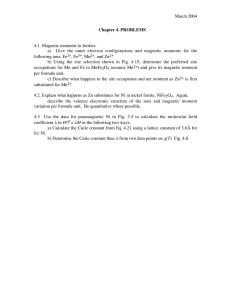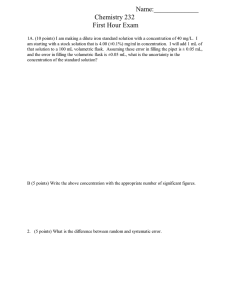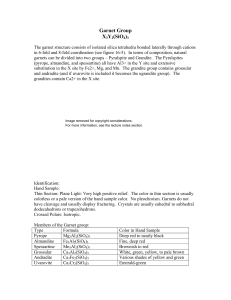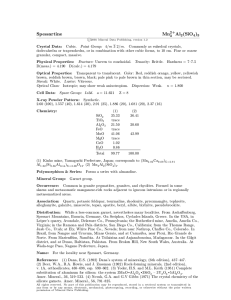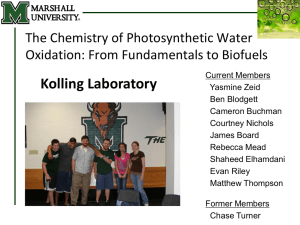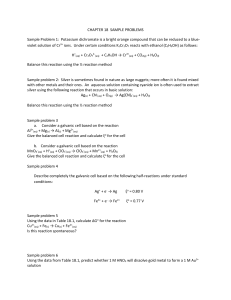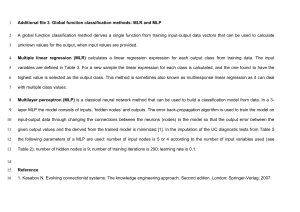Solution combustion derived nanocrystalline Zn SiO :Mn phosphors: A spectroscopic view
advertisement
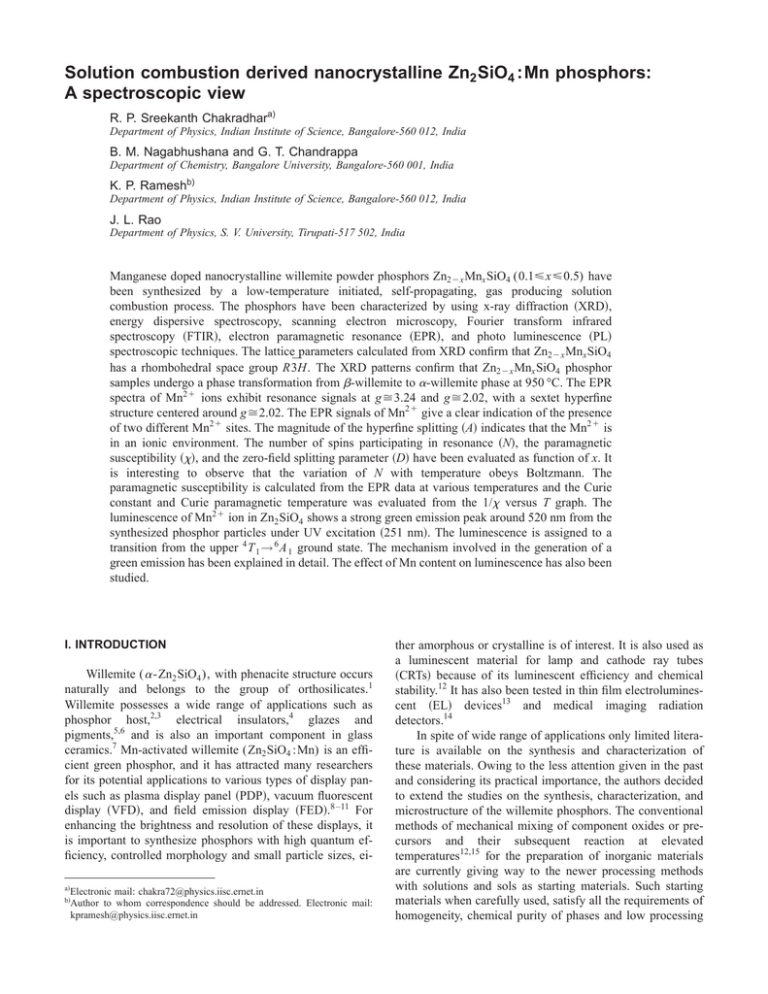
Solution combustion derived nanocrystalline Zn2 SiO4 :Mn phosphors: A spectroscopic view R. P. Sreekanth Chakradhara) Department of Physics, Indian Institute of Science, Bangalore-560 012, India B. M. Nagabhushana and G. T. Chandrappa Department of Chemistry, Bangalore University, Bangalore-560 001, India K. P. Rameshb) Department of Physics, Indian Institute of Science, Bangalore-560 012, India J. L. Rao Department of Physics, S. V. University, Tirupati-517 502, India Manganese doped nanocrystalline willemite powder phosphors Zn2⫺x Mnx SiO4 (0.1⭐x⭐0.5) have been synthesized by a low-temperature initiated, self-propagating, gas producing solution combustion process. The phosphors have been characterized by using x-ray diffraction 共XRD兲, energy dispersive spectroscopy, scanning electron microscopy, Fourier transform infrared spectroscopy 共FTIR兲, electron paramagnetic resonance 共EPR兲, and photo luminescence 共PL兲 spectroscopic techniques. The lattice parameters calculated from XRD confirm that Zn2⫺x Mnx SiO4 has a rhombohedral space group R3̄H. The XRD patterns confirm that Zn2⫺x Mnx SiO4 phosphor samples undergo a phase transformation from -willemite to ␣-willemite phase at 950 °C. The EPR spectra of Mn2⫹ ions exhibit resonance signals at g⬵3.24 and g⬵2.02, with a sextet hyperfine structure centered around g⬵2.02. The EPR signals of Mn2⫹ give a clear indication of the presence of two different Mn2⫹ sites. The magnitude of the hyperfine splitting 共A兲 indicates that the Mn2⫹ is in an ionic environment. The number of spins participating in resonance 共N兲, the paramagnetic susceptibility 共兲, and the zero-field splitting parameter 共D兲 have been evaluated as function of x. It is interesting to observe that the variation of N with temperature obeys Boltzmann. The paramagnetic susceptibility is calculated from the EPR data at various temperatures and the Curie constant and Curie paramagnetic temperature was evaluated from the 1/ versus T graph. The luminescence of Mn2⫹ ion in Zn2 SiO4 shows a strong green emission peak around 520 nm from the synthesized phosphor particles under UV excitation 共251 nm兲. The luminescence is assigned to a transition from the upper 4 T 1 → 6 A 1 ground state. The mechanism involved in the generation of a green emission has been explained in detail. The effect of Mn content on luminescence has also been studied. I. INTRODUCTION Willemite ( ␣ -Zn2 SiO4 ), with phenacite structure occurs naturally and belongs to the group of orthosilicates.1 Willemite possesses a wide range of applications such as phosphor host,2,3 electrical insulators,4 glazes and pigments,5,6 and is also an important component in glass ceramics.7 Mn-activated willemite (Zn2 SiO4 :Mn) is an efficient green phosphor, and it has attracted many researchers for its potential applications to various types of display panels such as plasma display panel 共PDP兲, vacuum fluorescent display 共VFD兲, and field emission display 共FED兲.8 –11 For enhancing the brightness and resolution of these displays, it is important to synthesize phosphors with high quantum efficiency, controlled morphology and small particle sizes, eia兲 Electronic mail: chakra72@physics.iisc.ernet.in Author to whom correspondence should be addressed. Electronic mail: kpramesh@physics.iisc.ernet.in b兲 ther amorphous or crystalline is of interest. It is also used as a luminescent material for lamp and cathode ray tubes 共CRTs兲 because of its luminescent efficiency and chemical stability.12 It has also been tested in thin film electroluminescent 共EL兲 devices13 and medical imaging radiation detectors.14 In spite of wide range of applications only limited literature is available on the synthesis and characterization of these materials. Owing to the less attention given in the past and considering its practical importance, the authors decided to extend the studies on the synthesis, characterization, and microstructure of the willemite phosphors. The conventional methods of mechanical mixing of component oxides or precursors and their subsequent reaction at elevated temperatures12,15 for the preparation of inorganic materials are currently giving way to the newer processing methods with solutions and sols as starting materials. Such starting materials when carefully used, satisfy all the requirements of homogeneity, chemical purity of phases and low processing temperatures besides fine particle size with uniform size distribution and large surface area of the synthesized phases.16,17 The other methods like r.f. magnetron sputtering,12 sol-gel process,18,19 single polymer precursor route,20 charge liquid cluster beam technique21 have also been reported in the literature. The present work aims to synthesize nanosized crystalline Zn2⫺x Mnx SiO4 (0.1⭐x⭐0.5) powder phosphors by a low temperature initiated, self-propagating, gas producing solution combustion process.22,23 The advantages of solution combustion method includes 共a兲 well crystallized oxides can be obtained at shorter times, 共b兲 it requires little or no further processing such as milling and firing, 共c兲 there is substantial saving of energy as well as cost since the reaction is sustained by heat generated from the chemical reaction between metal nitrates and fuel. The synthesized powders have been characterized by using XRD, EDS, SEM, FTIR, EPR, and PL spectroscopic techniques and the results obtained are discussed in detail. II. EXPERIMENT A. Combustion synthesis of willemite phosphors The starting materials Zn共NO3 ) 2 •6H2 O, silica fume (SiO2 surface area 200 m2/g兲 were the source of Zn and Si used for combustion synthesis of willemite phosphor. Diformyl hydrazine (C2 H4 N2 O2 , DFH兲 was used as a fuel for combustion synthesis which was prepared by the reaction of formic acid and hydrazine hydrate as described in the literature.24 Mn共NO3 ) 2 •4H2 O is used as a source of Mn. All the chemicals used were of Analar grade quality. B. Calculation of stoichiometry The stoichiometry of the redox mixture used for the combustion has been calculated using the total oxidizing and reducing valencies of the compounds which serve as numerical coefficients for the stoichiometric balance so that the equivalent ratio ( e ) is unity and the energy released by the combustion is maximum.25 According to this concept, the valence of C⫽⫹4, H⫽⫹1, divalent metal ions⫽⫹2, trivalent metal ions⫽⫹3, and O⫽⫺2. The valence of nitrogen is considered to be zero. Based on these considerations, the zinc nitrate has an oxidizing valence of ⫺10 and DFH (C2 H4 N2 O2 ) a reducing valence of ⫹8. The detailed calculation of stoichiometry has been reported elsewhere.25 In the actual synthesis appropriate stoichiometry of Zn共NO3 ) 2 •6H2 O and DFH were dissolved in a minimum quantity of water in a cylindrical petridish 共100 mm diameter and 50 mm height兲 capacity. To this solution fumed silica was added and dispersed well. The heterogeneous redox mixture was rapidly heated by introducing into a muffle furnace maintained at 500⫾10 °C. The redox mixtures containing the metal nitrates, silica fume and DFH when rapidly heated around 500 °C, dehydrates forming a honeylike gel, which ignites to yield voluminous foamy willemite powder. Theoretical equations assuming the complete combustion of the redox mixture used for the synthesis of willemite may be written as 4Zn共NO3 ) 2 共 aq兲 ⫹2SiO2 共 s兲 ⫹5C2 H4 N2 O2 共 aq兲 共 DFH兲 2Zn2 SiO4 共 s兲 ⫹9N2 共 g兲 ⫹10H2 O共g)⫹10CO2 共 g兲 . It is interesting to note that the combustion reaction was violent when fused SiO2 共particle size⬇10 m兲 was used instead of fumed silica 共particle size⬇1 m兲 as source of silicon. The violent combustion reaction may be due to the noninvolvement of fused SiO2 with other constituents during combustion because of its large particle size as compared to fumed SiO2 . The dispersed phase 共fumed SiO2 ) controls the violent reaction as the combustible gases get trapped in the pores of the foam. In the synthesis of Mn-doped samples, Mn共NO3 ) 2 •4H2 O was added along with Zn共NO3 ) 2 •6H2 O. C. Characterization of phosphors An x-ray powder diffractometer 共Philips PW 1050/70兲 using Cu K ␣ radiation with a Ni filter was used to estimate the crystallinity of the phases. The surface morphology, distribution of the grains and EDS 共energy dispersive spectroscopy兲 of the samples were examined on a JEOL 共JSM-840A兲 共1兲 SEM. The FTIR spectral studies have been performed on a Perkin-Elmer spectrophotometer 共spectrum 1000兲 with KBr pellets. The EPR spectra were recorded at room temperature as well as at different temperatures using a JEOL-FE-1X ESR spectrometer operating in the X-band frequency 共⬇9.2 GHz兲 with a field modulation frequency of 100 kHz. The magnetic field was scanned from 0 to 500 mT and the microwave power used was 5 mW. A powdered specimen of 100 mg was taken in a quartz tube for EPR measurements. The EPR spectrum of Zn1.50Mn0.5SiO4 powder phosphor sample was recorded at different temperatures using a variable temperature controller 共JES UCT 2AX兲. A temperature stability of ⫾1 K was easily obtained by waiting approximately half an hour at the set temperature before recording a spectrum at each temperature. Photoluminescent excitation and emission spectra were recorded with a Shimadzu spectrofluorophoto meter 共model RF 510兲 equipped with a 150 W xenon lamp as an FIG. 1. Powder XRD patterns of solution combustion derived undoped willemite 共a兲 as-formed, 共b兲 500 °C 共3 H兲, 共c兲 950 °C 共3 H兲. excitation source. The emission spectra were studied using an excitation wavelength of 251 nm. III. RESULTS AND DISCUSSION The powder x-ray diffraction patterns of undoped and doped willemite phosphors obtained by solution combustion process are shown in Figs. 1 and 2, respectively. The asformed willemite powder is weakly crystalline with broad peaks corresponding to Zn2 SiO4 along with ZnO 共JCPDS No. 37-7485 and 37-1485兲 phases. On calcination 共950 °C兲, the powders fully crystallize at the expense of ZnO to give a single phase Zn2 SiO4 共Fig. 1兲. Similarly, the Mn doped willemite powders sintered at 950 °C show full crystallinity with small ZnO peak at low Mn doped, but it disappears in high doped powders as shown in Fig. 2. Most intense peaks at d⫽2.624, 2.823, and 3.465 Å do not vary significantly with Mn doping. This suggests crystallinity is therefore independent of Mn content. Table 1 lists the composition and lattice parameters of Zn2⫺x Mnx SiO4 (0.1⭐x⭐0.5) phosphors evaluated from the XRD patterns by using Rietveld analysis program Fullprof,26 assuming the R3̄H space group. The analysis confirm that these powders have a rhombohedral space group (R3̄H) and are in good agreement with those reported in literature.27,28 The nominal compositions of the samples were also confirmed by EDS method. The SEM micro graphs of Zn2⫺x Mnx SiO4 (x⫽0.1 and 0.5兲 sintered 共950 °C兲 共3 H兲 samples are shown in Fig. 3. The SEM morphology shows small and round shaped grains which are little bit agglomerated. On calcination the agglomeration size increases. The mean size measured from the scanning electron micrographs is about 0.2–1.2 m. Also it is well known that the particles prepared using other techniques such as solid state, coprecipitate and hydrothermal are irregular in shape and large.29–31 The use of spherical shape particles should increase screen brightness and improve the resolution due to lower scattering of the evolved light and higher packing densities than irregular shaped particles.11 Using Scherrer’s formula,32 the crystallite size of the samples was calculated from the XRD patterns also. The results show that the particles synthesized in the present investigations are ⬇29 to 37 nm. Figure 4 shows the FTIR spectra of the undoped willemite, as formed and calcined sample 共950 °C兲. It is interesting to observe that as-formed samples exhibit -willemite phase whereas calcined sample shows ␣-willemite phase. This also supports our XRD studies 共Fig. 1兲. Figure 5 shows the FTIR spectra of all the doped samples calcined at 950 °C which are in ␣-willemite phase. It is observed that the main absorption peaks of this phosphor fall in the frequency region 350–1200 cm⫺1. The IR bands and corresponding vibrational modes for willemite are 870 cm⫺1 ( 1 SiO4 ); 978, 934, and 900 cm⫺1 ( 3 SiO4 ); 460, 396, and 380 cm⫺1 ( 4 SiO4 ); 578 cm⫺1 ( 1 ZnO4 ); and 616 cm⫺1 ( 3 ZnO4 ), where 1 corresponds to totally sysmmetric stretching, 3 is asymmetric stretching and 4 asymmetric deformation.23,33,34 The absorption at 470 cm⫺1 corresponds to ZnO stretching35 and it is observed that the intensity of this absorption increases with increase of Mn content. A. Electron paramagnetic resonance studies FIG. 2. Powder XRD patterns of solution combustion derived Zn2⫺x Mnx SiO4 (0.1⭐x⭐0.5) calcined at 950 °C 共3 H兲 as a function of x. The EPR spectroscopy has been used as a tool to elucidate the structural evolution of the materials. We used divalent Mn as a probe; Mn2⫹ is a sensitive indicator of structural changes owing to its unshielded d 5 ions. Host-activator compositions are of considerable interest for elucidating the structure and bonding in vitreous 共isotropic兲 and crystalline 共anisotropic兲 systems. In undoped samples we have not ob- TABLE I. Composition and lattice parameters of Zn2⫺x Mnx SiO4 (0.1⭐x⭐0.5) phosphors 共R⫽rhombohedral; @ accurate within⫾0.009兲. Sample Zn1.90Mn0.1SiO4 Zn1.85Mn0.15SiO4 Zn1.8Mn0.2SiO4 Zn1.75Mn0.25SiO4 Zn1.7Mn0.3SiO4 Zn1.5Mn0.5SiO4 Lattice parameters 共Å兲@ Crystal structure R3̄H R3̄H R3̄H R3̄H R3̄H R3̄H a c 13.947共7兲 13.953共6兲 13.951共5兲 13.948共6兲 13.944共5兲 13.946共5兲 9.314共3兲 9.317共2兲 9.316共2兲 9.314共2兲 9.312共2兲 9.315共2兲 Cell volume 共Å3兲 1569.08共13兲 1570.85共10兲 1570.28共10兲 1569.48共08兲 1568.05共10兲 1568.98共08兲 served EPR signal indicating that the starting materials used in the present work are free from paramagnetic impurities. Figure 6 shows the EPR spectra of Mn2⫹ doped Zn2⫺x Mnx SiO4 (0.1⭐x⭐0.5) phosphors as a function of x. The EPR spectra of all the investigated samples exhibit a six-line hyperfine structure centered at g⬵2.02 with a total peak width of ⬵490 G as shown in Fig. 6. The six-line hyperfine structure 共hfs兲 arising at g⬵2.02 is due to the interaction of electron spin of manganese ions with its own nuclear spin I⫽5/2. In addition to this, a broad shoulder around g⬵3.24 has also been observed. The observation of EPR signals of Mn2⫹ give a clear indication of two kinds of Mn2⫹ sites. Therefore the EPR spectrum of Mn2⫹ ions is due to isolated Mn2⫹ ions giving the six-line hyperfine structure plus a very broad line due to dipolar interaction between Mn2⫹ – Mn2⫹ neighbors. An EPR study of Mn doped willemite by Perkins and Sienko36 also indicated that both sites are accessible to Mn2⫹ . Bulk Zn2 SiO4 :Mn 共at 950 °C兲 crystallizes in phenacite structure and belongs to rhombohedral space group as both Zn2⫹ and Si4⫹ ions coordinated tetrahedrally to four oxygen atoms. There are two nonequivalent crystallographic Zn sites present in willemite both having nearest neighboring oxygen in a slightly distorted tetrahedral (T d) configuration. Both sites are accessible to Mn2⫹ , since ionic radii of the two ions are very similar 共0.74 Å for Zn2⫹ and 0.80 Å for Mn2⫹ ) and also due to the identical valency. Therefore the Mn ions doped Zn2 SiO4 also have four-coordination 共weak crystal field兲 because they replace some of the Zn2⫹ ions in the lattice.2 From EPR spectra, the spin-Hamiltonian parameters g and A have been evaluated. Table 2 gives some typical values of the hyperfine splitting 共A兲 values for the Zn2⫺x Mnx SiO4 (0.1⭐x⭐0.5) phosphors as a function of x at room temperature. It is apparent from different average values of A measured from peak to peak (A pp) and trough to trough (A tt) that the individual lines are strain broadened, leading to an asymmetry in the absorption spectrum.37 The FIG. 3. The SEM morphology of solution combustion derived Zn2⫺x Mnx SiO4 samples calcined at 950 °C 共3 H兲 共a兲 x⫽0.1, 共b兲 x⫽0.5. FIG. 4. FTIR spectra of the solution combustion derived undoped willemite powders 共a兲 as-formed and 共b兲 calcined at 共950 °C兲 共3 H兲. FIG. 6. The X-band EPR spectra of Zn2⫺x Mnx SiO4 (0.1⭐x⭐0.5) phosphor samples as a function of x at room temperature. FIG. 5. FTIR spectra of the solution combustion derived Zn2⫺x Mnx SiO4 (0.1⭐x⭐0.5) calcined at 950 °C 共3 H兲 as a function of x. first derivative spectrum as a consequence, shows larger values of A, when measured trough to trough, rather than peak to peak. An overall average was calculated from A avg⫽ 关共 ⌬ Opp⫹⌬ Ott兲 /5⫹ 共 ⌬ Mpp⫹⌬ Mtt兲 /3⫹ 共 ⌬ Ipp⫹⌬ Itt兲兴 /6, 共2兲 where ⌬ Opp and ⌬ Ott represent the differences between the first and sixth peak positions, measured peak to peak and trough to trough respectively. ⌬ Mpp and ⌬ Mtt represents difference in positions between second and fifth peaks and ⌬ Ipp and ⌬ Itt between second and third peaks. It is interesting to note that, in all of the samples, ⌬ Opp/5⬇⌬ Mpp/3⬇⌬ Ipp and ⌬ Ott/5⬇⌬ Mtt/3⬇⌬ Itt . This indicates that the g value in each case is well behaved.37 The strength of the hyperfine splitting 共A兲 depends on the matrix into which the ion is dissolved and is mainly determined by the electronegativity of the neighbors. This means a qualitative measure of the covalency of the bonding in the matrix which can be determined from the value of A; the smaller the splitting, the more covalent the bonding of the anion. The g value for the hyperfine splitting is indicative of the nature of bonding in the matrix. If the g value shows a negative shift with respect to 2.0023, then the bonding is ionic and conversely, if the shift is positive, then the bonding is more covalent in nature. In the present work, from the measured negative shift in the g value, with respect to 2.0023 as well as from A values, it is apparent that the Mn2⫹ ion is in an ionic environment. It is also observed that the linewidth, and g and A values are found to be independent of temperature. B. Calculation of number of spins „N… participating in resonance The number of spins participating in resonance can be calculated by comparing the area under the absorption curve with that of a standard (CuSO4 •5H2 O in this study兲 of known concentration. Weil et al.38 gave the following expression which includes the experimental parameters of both sample and standard: TABLE II. The hyperfine splitting 共A兲, number of spins participating in resonance 共N兲, paramagnetic susceptibility 共兲 and zero-field splitting parameter 共D兲 for (Zn2⫺x Mnx SiO4 ) (0.1⭐x⭐0.5) as a function of x at room temperature. Sample (Zn2⫺x Mnx SiO4 ) x⫽0.10 x⫽0.15 x⫽0.20 x⫽0.25 x⫽0.30 x⫽0.50 A avg ⫻10⫺4 cm⫺1 N⫻1020 共arbitrary units兲 ⫻10⫺4 共m3 Kg⫺1兲 D 共Gauss兲 75.1 74.8 75.5 78.3 74.1 75.2 7.44 11.75 17.36 19.67 20.24 45.83 1.87 2.95 4.36 4.94 5.08 11.5 227 232 234 247 258 268 FIG. 7. A plot of ln Ng⫽2.02 against 1/T for the Zn1.5Mn0.5SiO4 powder phosphor sample. N⫽ A x 共 Scan x 兲 2 G std共 B m 兲 std共 g std兲 2 关 S 共 S⫹1 兲兴 std共 P std兲 1/2 A std共 Scan std兲 2 G x 共 B m 兲 x 共 g x 兲 2 关 S 共 S⫹1 兲兴 x 共 P x 兲 1/2 ⫻ 关 Std兴 , 共3兲 where A is the area under the absorption curve which can be obtained by double integrating the first derivative EPR absorption curve, scan is the magnetic field corresponding to unit length of the chart, G is the gain, B m is the modulation field width, g is the g factor, S is the spin of the system in its ground state. P is the power of the microwave. The subscripts ‘‘x’’ and ‘‘Std’’ represent the corresponding quantities for Mn2⫹ glass sample and the reference (CuSO4 •5H2 O), respectively. It is observed that the number of spins participating in resonance for g⬵2.02 increase with x and is presented in Table 2. This increase in N is due to more number of Mn content is entering the matrix as a paramagnetic impurity. Figure 7 shows a plot of ln Ng⫽2.02 against 1/T in 100 mg of the powder phosphor sample Zn1.5Mn0.5SiO4 . From the plot it can be seen that, as the temperature is lowered the number of spins increases obeying the usual Boltzmann law. The data is least square fit to a straight line ln N⫽(56.6/T) ⫹1.81. The activation energy thus calculated was found to be 1.798⫻10⫺21 J 共0.0112 eV兲 which is the same order expected for a paramagnetic ion. C. Calculation of paramagnet ic susceptibility „… from EPR data The EPR data can be used to calculate the paramagnetic susceptibility of the sample using the formula,39 Ng  J共J⫹1) , 3kB共 T⫹⌬ 兲 2 ⫽ 2 共4兲 where N is the number of spins per m3 and the other symbols have their usual meaning. When Weiss constant ⌬ vanishes, FIG. 8. The variation of reciprocal of paramagnetic susceptibility 共1/兲 as a function of absolute temperature 共T兲 for the Zn1.5Mn0.5SiO4 powder phosphor sample. Eq. 共4兲 follows Curie’s law. N can be calculated from Eq. 共3兲 and g⫽2.02 is taken from EPR data. The paramagnetic susceptibility have also been evaluated with respect to x and is presented in Table 2. The temperature dependence of reciprocal of the paramagnetic susceptibility 共1/兲 of Mn2⫹ ions in Zn1.5Mn0.5SiO4 phosphor sample is presented in Fig. 8. The data is fit to a straight line in accordance with CurieWeiss-type behavior 关 ⫽C/(T⫺ p) 兴 . It is interesting to note that with increasing temperature, the susceptibility of the sample decreases obeying the Curie-Weiss law. Further from the slope of the line the Curie constant and the paramagnetic Curie temperature have been evaluated and are found to be 55.23⫻10⫺3 emu mol⫺1 and p⫽⫺55 K, respectively. The Curie constant calculated in the present work is in good agreement with the value reported for the paramagnetic ion by Ardelean et al.40 The paramagnetic Curie temperature is negative for the investigated sample implying that the manganese ions are antiferromagnetically coupled by negative super exchange interactions at very low temperatures. D. Calculation of zero-field splitting parameter „D… from EPR spectra from the allowed hyperfine lines The intensity of hyperfine lines can be used to calculate the zero-field splitting parameter 共D兲 from the ratio of allowed hyperfine lines 共corresponding to the selection rule ⌬m⫽0) using the formula41 I m ⬀2 A 2 共 35⫺4m 2 兲 ⫹ 2共 gH 兲2 ⫺ 5.334D 2 35.14D 2 共 35⫺4m 2 兲 共gH兲 共 gH 兲2 208D 4 共 35⫺4m 2 兲 2 共 gH 兲4 , ⫺ 2 共5兲 FIG. 10. Emission spectra of phosphor particles at room temperature in solution combustion derived Zn2⫺x Mnx SiO4 (0.1⭐x⭐0.5) samples calcined at 950 °C 共3 H兲 as a function of x under an excitation of 251 nm. FIG. 9. The excitation spectra taken at the peak emission 共⬇520 nm兲 at room temperature in solution combustion derived Zn2⫺x Mnx SiO4 (0.1⭐x ⭐0.5) calcined at 950 °C 共3 H兲 as a function of x. where m is the nuclear spin magnetic quantum number, I m is the intensity of the mth allowed hyperfine 共HF兲 line, A is the HF splitting constant, D is the zero-field splitting parameter, and the rest of the symbols have their usual meaning. The D values evaluated in the present work is listed in Table 2. It is observed that D increases with x. IV. PHOTOLUMINESCENCE STUDIES The photoluminescence 共PL兲 of Zn2⫺x Mnx SiO4 (0.1⭐x ⭐0.5) phosphors have been characterized by the transitions of 3d 5 of Mn2⫹ electrons in the manganese ion acting as an activating center. In a cubic crystalline field of low to moderate strength, the five d electrons of Mn2⫹ ion are distrib- uted in the t 2g and e g orbitals, with three in the former and two in the latter. Thus the ground state configuration is (t 2g ) 3 (e g ) 2 . This configuration gives rise to the electronic states, 6 A 1g , 4 A 1g , 4 E g , 4 T 1g , 4 T 2g , and to a number of doublet states of which 6 A 1g lies lowest according to Hund’s rule. Since, all the excited states of Mn2⫹ ion 共belonging to d 5 configuration兲 will be either quartets or doublets, the luminescence spectra of Mn2⫹ ions will have only spin forbidden transitions. Figure 9 shows an excitation spectrum of Zn2⫺x Mnx SiO4 (0.1⭐x⭐0.5) phosphor with a strong excitation peak at 251 nm, obtained by monitoring the strong green emission wavelength at 520 nm 共see Fig. 9兲 or the band at 251 nm is considered to be responsible for the emission at 520 nm. The broad strong excitation peak at 251 nm could be attributed to a charge transfer transition from the divalent manganese ground state 6 A 1 (S) of (Mn2⫹ ) to the conduction band 共CB兲. The corresponding emission spectra of Zn2 SiO4 :Mn (0.1⭐x⭐0.5) phosphor is shown in Fig. 10. In the present work we observed interesting new results. In addition to strong green emission 共520 nm兲, we also observed weak blue 共430– 460 nm兲 and violet 共390 nm兲 emissions from the same material for a single excitation wavelength of 251 nm. To the best of our knowledge we have not come across such an emission spectra consisting of three wavelengths simultaneously in this series of Zn2 SiO4 :Mn phos- FIG. 11. The excitation and emission spectra of undoped solution combustion derived willemite sample calcined at 950 °C 共3 H兲. phors reported so far. Most of the available reports indicate only green emission. In order to probe for the origin of additional colors in the emission spectra we have performed PL studies in undoped samples also. Surprisingly the PL spectra of undoped samples also showed very weak two emission peaks at about 395 nm 共UV band兲 and 465 nm 共blue band兲 from emission spectra when excited at 260 nm. The excitation and emission spectra of undoped sample is shown in Fig. 11 and the absence of green emission is due to the absence of Mn2⫹ . Further our EPR experiment in undoped sample also shows the absence of EPR signal, indicating that it is free from paramagnetic impurities. Therefore, we attribute these additional bands in our samples at about ⬃390 and ⬃460 nm to be originating from ZnO. The UV emission at ⬃390 nm has been well studied and was ascribed to excitonic recombination of ZnO. It is well known42 that the valence band 共VB兲 and CB in semiconductors retain their meaning even in the amorphous state, and the density of bands is almost unaltered by amorphisation since the gross feature of electronic states is determined by the short range order. The photophysics of emission band at ⬃390 nm can be predicted by the following scheme: First, the excitation photon may lose energy of ⬃2 eV due to vibrational absorption in the silica network before exciting the electron from VB to CB of ZnO. A similar energy loss process is reported in porous silica.43 Second, the excited electrons move towards the band edge and recombine directly with the photogenerated holes to give the 390 nm emission. For different syntheses approaches, the near band edge emission peaked at ⬃380 nm was also reported.44 – 47 Blue light luminescence located at 430– 460 nm has been reported by Fu et al.48 in their ZnO films deposited on a Si substrate. Similarly, a very weak 470 nm blue emission peak was reported by Li et al.49 in their ZnO/Zn phosphor films. Only a few results48 –52 on this emission have been reported and its mechanism is still being debated. Zhang et al.52 reported monochromatic blue luminescence from sputtered ZnO films and ascribed it to shallow donor level of oxygen vacancy and interstitial zinc. Other possible origins such as zinc vacancy48 and interstitial oxygen50 have also been proposed to explain this blue emission. Zhang et al. reported that a 446 nm blue emission was observed in their FIG. 12. Energy level scheme for the green emission process in Zn2⫺x Mnx SiO4 (0.1⭐x⭐0.5) samples upon excitation with 251 nm of Xe lamp. ZnO films deposited on a glass substrate52 when exited with a 270 nm light. Recently Xu et al.53 reported a new evidence for 453 nm blue band by resolving the unsymmetric UV band of the annealed ZnO film in their study of formation mechanism of Zn2 SiO4 crystal. They also pointed out that the 453 nm blue luminescence is from an unknown blue center and they reasonably attributed these blue centers in the ␣ -SiO2 to the ZnO film deposited on silicon. In the present investigations interestingly we observed all the features described above in our samples, especially the green, blue, and violet emissions with a single excitation wavelength. The intensities of the blue and violet are weak compared to strong green emission. In undoped samples the green emission was absent, hence we deduce that the strong green photoemission originates from Mn2⫹ . Therefore, in this study the strong green light emitted from the Mn2⫹ doped Zn2 SiO4 phosphor particles under UV excitation and has been assigned to an electronic transition of 4 T 1 (G) → 6 A 1 (S) peaking at the wavelength 520 nm and which is parity forbidden emission transition of Mn2⫹ ions.54 The Mn2⫹ ion site substituting the Zn2⫹ in the Zn2 SiO4 lattice is considered to be the emission center of the Zn2 SiO4 :Mn phosphor because Zn2⫹ and Mn2⫹ ions have similar oxidation states and their radii are similar; therefore Mn2⫹ ions FIG. 13. Green color 共520 nm兲 emission dependence in Zn2⫺x Mnx SiO4 (0.1⭐x⭐0.5) samples as a function of x upon excitation with 251 nm of Xe lamp. could be well distributed as the substitutes of Zn2⫹ in the zinc silicate host matrix and hence the encouraging green emission. The valence matching between Mn and Zn could lead to a high solid solubility even at low temperatures without any charge compensators.55 The mechanism involved in the generation of a green emission in this system is shown in Fig. 12. The electron from the ground state of Mn2⫹ ( 6 A 1 ) is excited to the conduction band of the Zn2 SiO4 by photons. This process may be explained as Mn 2⫹ ⫹h →Mn 3⫹ ⫺ ⫹e , where h is the energy needed in causing the photoexcitation of Mn2⫹ in Zn2 SiO4 . The free electrons in the conduction band can relax to the 4 T 1 excited state by nonradiative process and then followed by radiative transition from the excited state 4 T 1 → 6 A 1 ground state emitting a strong green light. The brightness of the emission from the phosphor particles is strongly affected by doping concentration of Mn2⫹ . The dependence of emission intensity with doping is shown in Fig. 13. It is observed that the emission intensity increases linearly with Mn content up to x⫽0.2; afterwards it begins to saturate. The dependence of emission intensity on Mn content has also been reported in literature.56 – 62 In the present investigation the origin of blue and violet emissions are not clear. However, it is reasonable to attribute this to the fact that it may be originating from the zinc vacancy. V. CONCLUSIONS Zn2⫺x Mnx SiO4 (0.1⭐x⭐0.5) nanocrystalline powder phosphors have been synthesized by a low-temperature initiated, self-propagating, gas producing combustion process. The lattice parameters calculated from XRD confirm that Zn2⫺x Mnx SiO4 has a rhombohedral space group (R3̄H). The XRD patterns confirm that Zn2⫺x Mnx SiO4 phosphor samples undergo a phase transformation from -willemite to ␣-willemite phase at 950 °C. The EPR spectra of Mn2⫹ ions exhibit resonance signals at g⬵3.24 and g⬵2.02, with a sextet hyperfine structure centered around g⬵2.02. The observation of EPR signals of Mn2⫹ gives clear indication of two kinds of Mn2⫹ sites. The magnitude of hyperfine split- ting 共A兲 for Mn2⫹ ion indicates that the Mn2⫹ ion is in an ionic environment. It is observed that N, , and D increases with increase of x. The variation of N with temperature obeys usual Boltzmann law. The activation energy was calculated and found to be 0.0112 eV. It is interesting to observe that the temperature dependence of reciprocal of susceptibility obeys Curie-Weiss law. The Mn ions in doped Zn2 SiO4 also have four-coordination because they replace some of the Zn2⫹ ions in the lattice. The luminescence of Mn2⫹ ion in Zn2 SiO4 shows a strong green emission peak around 520 nm from the synthesized phosphor particles under UV excitation 共251 nm兲. The luminescence is assigned to a transition from the upper 4 T 1 → 6 A 1 ground state. In addition to this, blue and violet emissions are also observed for single excitation wavelength 共251 nm兲. The origin for green emission is from Mn2⫹ center, whereas blue and violent emissions may be originating from the zinc vacancy. ACKNOWLEDGMENTS The authors thank DST, DAE-BRNS for providing financial assistance. R.P.S.C. is grateful to the Science and Engineering Research Council SERC 共Department of Science and Technology, DST兲, New Delhi, for the award of Fast Track research project under Young scientist scheme. 1 J. A. Speer and P. H. Ribbe, in Reviews in Mineralogy, 2nd ed., edited by P. H. Ribbe 共Mineralogical Society of America, Washington, DC, 1982兲, Vol. 5, p. 429. 2 K. C. Mishra, K. H. Johnson, B. G. Deboer, J. K. Berkowitz, J. Olsen, and E. A. Dale, J. Lumin. 47, 197 共1991兲. 3 C. Bartohu, J. Benoit, P. Bennalloul, and A. Morell, J. Electrochem. Soc. 141, 524 共1994兲. 4 D. Lepkova, A. Nenov, L. Pavlova, and I. Ivalnov, Stroit. Materi. Silik. Promst. 21, 18 共1980兲. 5 J. Alarcon, P. Escribano, and R. Maria Martin, Br. Ceram. Trans. J. 84, 170 共1985兲. 6 E. Rosello, A. Borrio, M. Guillem, and M. Cormen, Br. Ceram. Trans. J. 84, 175 共1985兲. 7 Z. Strand, Glass Science and Technology 共Elsevier, Amsterdam, 1986兲, Vol. 8, p. 101. 8 J. McKittrick, L. E. Shea, C. F. Bacalski, and E. J. Bosze, Displays 19, 169 共1999兲. 9 Y. C. Kang, I. W. Lenggoro, S. B. Park, and K. Okuyama, J. Phys. Chem. Solids 60, 1855 共1999兲. 10 L. E. Shea, J. McKittrick, and O. A. Lopez, J. Am. Ceram. Soc. 79, 3257 共1996兲. 11 Phosphor Handbook, edited by S. Shionoya and W. M. Yen, Phosphor Research Society 共Japan兲 共CRC, Boca Raton, FL, 1999兲. 12 H. C. Swart, T. A. Trottier, J. S. Sebastian, S. L. Jones, and P. H. Holloway, J. Appl. Phys. 83, 4578 共1998兲. 13 T. Minami, T. Miyata, S. Takata, and I. Fukuda, Jpn. J. Appl. Phys., Part 2 30, L117 共1991兲. 14 I. Kandarakis, D. Cavouras, P. Prassopoulos, E. Kanellopoulos, C. D. Nomicos, and G. S. Panayiotakis, Appl. Phys. A: Mater. Sci. Process. 67, 521 共1998兲. 15 D. Segal, Chemical Synthesis of Advanced Ceramic Materials 共Cambridge University Press, Cambridge, 1989兲. 16 C. R. Veale, Fine Powders: Preparation, Properties and Uses 共Applied Science Publishers, London, 1972兲. 17 K. S. Sohn, B. Cho, and H. D. Park, J. Am. Ceram. Soc. 82, 2779 共1999兲. 18 R. Morimo and K. Matae, Mater. Res. Bull. 24, 175 共1989兲. 19 J. Lin, U. D. Sanger, M. Menning, and K. Barner, Mater. Sci. Eng., B 64, 73 共1999兲. 20 K. Su, T. D. Tilley, and M. J. Sailor, J. Am. Ceram. Soc. 118, 3459 共1996兲. 21 M. Cich, K. Kim, H. Choi, and S. T. Hwang, Appl. Phys. Lett. 73, 2116 共1998兲. 22 J. J. Kingsley and K. C. Patil, Mater. Lett. 6, 427 共1998兲. 23 G. T. Chandrappa, S. Ghosh, and K. C. Patil, J. Mater. Synth. Process. 7, 273 共1999兲. 24 C. Ainsworth and R. Jones, J. Am. Ceram. Soc. 77, 621 共1955兲. 25 S. R. Jain, K. C. Adiga, and V. R. Paiverneker, Combust. Flame 40, 71 共1981兲. 26 J. Rodriguez-Carvajal, Program Fullprof. 98, version 0.2 共1998兲. 27 R. W. G. Wyckoff, Cryst. Struct. Commun. 3, 134 共1963兲. 28 T. S. Ahmadi, M. Haase, and H. Weller, Mater. Res. Bull. 35, 1869 共2000兲. 29 I. F. Chang, J. W. Brownlow, T. I. Sun, and J. S. Wilson, J. Electrochem. Soc. 136, 3532 共1989兲. 30 A. Morell and N. El Khiati, J. Electrochem. Soc. 140, 2019 共1993兲. 31 Q. H. Li, S. Komarneni, and R. Roy, J. Mater. Sci. 30, 2358 共1995兲. 32 H. Klug and L. Alexander, X-ray Diffraction Procedures for Polycrystalline and Amorphous Materials 共Wiley, New York, 1974兲, p. 618. 33 P. Tarte, Spectrochim. Acta 18, 467 共1962兲. 34 C.-C. Lin and P. Shen, J. Non-Cryst. Solids 171, 281 共1994兲. 35 R. A. Nyquist and R. O. Kagel, Infrared Spectra of Inorganic Compounds 共Academic, New York, 1971兲. 36 H. K. Perkins and M. J. Sienko, J. Chem. Phys. 46, 2398 共1967兲. 37 J. R. Pilbrow, Bull. Magn. Reson. 9, 32 共1987兲. 38 J. A. Weil, J. R. Bolton, and J. E. Wertz, Electron Paramagnetic Resonance-Elementary Theory and Practical Applications 共Wiley, New York, 1994兲, p. 498. 39 N. W. Aschcroft and N. D. Mermin, Solid State Physics 共Harcourt Brace College Publishers, New York, 2001兲, p. 656. 40 I. Ardelean, O. Cozar, S. Filip, V. Pop, and I. Ceran, Solid State Commun. 100, 609 共1996兲. 41 B. T. Allen, J. Chem. Phys. 43, 3820 共1965兲. 42 S. Kondo, T. Itoh, and T. Saito, Phys. Rev. B 57, 13235 共1998兲. 43 B. D. Yao, H. Z. Shi, X. Y. Zhang, and L. D. Zhang, Appl. Phys. Lett. 78, 174 共2001兲. 44 Z. K. Tang, G. K. L. Wong, P. Yu, M. Kawasaki, A. Ohtomo, H. Koinuma, and Y. Segawa, Appl. Phys. Lett. 72, 3270 共1998兲. 45 M. H. Huang, Y. Wu, H. Feick, N. Tran, E. Weber, and P. Yang, Adv. Funct. Mater. 13, 113 共2001兲. 46 Y. C. Kong, D. P. Yu, B. Zhang, W. Fang, and S. Q. Feng, Appl. Phys. Lett. 78, 407 共2001兲. 47 M. H. Huang, S. Mao, H. Feick et al., Science 292, 1897 共2001兲. 48 Z. X. Fu, C. X. Guo, B. X. Lin, and G. H. Liao, Chin. Phys. Lett. 15, 457 共1998兲. 49 W. Li, D. S. Mao, Z. H. Zheng et al., Surf. Coat. Technol. 129–129, 346 共2000兲. 50 M. Shailaja, B. Kavita, B. S. Bendre, V. J. Leppert, and S. H. Risbud, J. Appl. Phys. 85, 2861 共1999兲. 51 T. Gao, G. W. Meng, Y. T. Tian, S. H. Sun, X. Liu, and L. D. Zhang, J. Phys.: Condens. Matter 14, 12651 共2002兲. 52 D. H. Zhang, Z. Y. Xue, and Q. P. Wang, J. Phys. D 35, 2837 共2002兲. 53 Xiaoliang Xu, Pei Wang, Zemin Qi et al., J. Phys.: Condens. Matter 15, L607 共2003兲. 54 A. Mornel and N. EL Khiati, J. Electrochem. Soc. 140, 2019 共1993兲. 55 Y. A. Ono, Electroluminescent Displays 共World Scientific, Singapore, 1995兲. 56 R. Morimo and K. Matae, Mater. Res. Bull. 24, 175 共1989兲. 57 I. F. Chang, J. W. Brownlow, T. I. Sun, and J. S. Wilson, J. Electrochem. Soc. 136, 3532 共1989兲. 58 A. Morell and N. El Khiati, J. Electrochem. Soc. 140, 2019 共1993兲. 59 C. Barthou, J. Benoit, P. Benalloul, and A. Morell, J. Electrochem. Soc. 141, 524 共1994兲. 60 M. Cich, K. Kim, H. Choi, and S. T. Hwang, Appl. Phys. Lett. 73, 2116 共1998兲. 61 K. S. Sohn, B. Cho, and H. D. Park, J. Am. Ceram. Soc. 82, 2779 共1999兲. 62 R. Selomulya, S. Ski, K. Pita, C. H. Kam, Q. Y. Zhang, and S. Buddhudu, Mater. Sci. Eng., B 100, 136 共2003兲.
